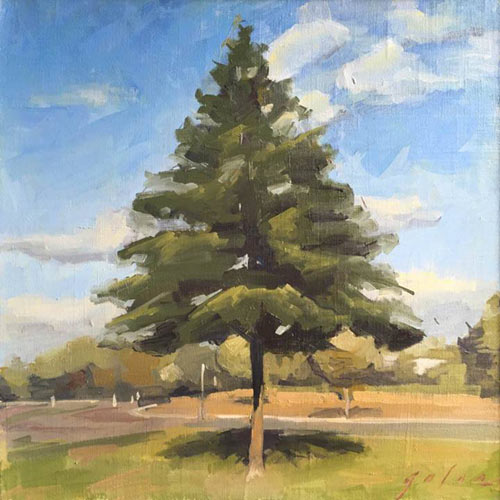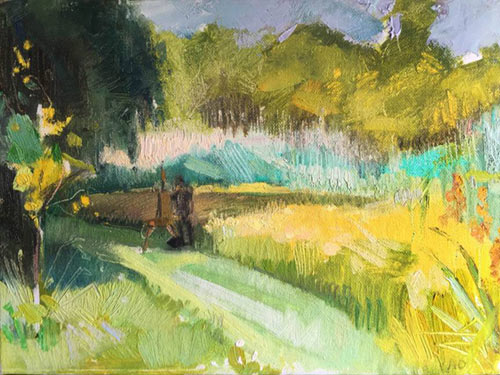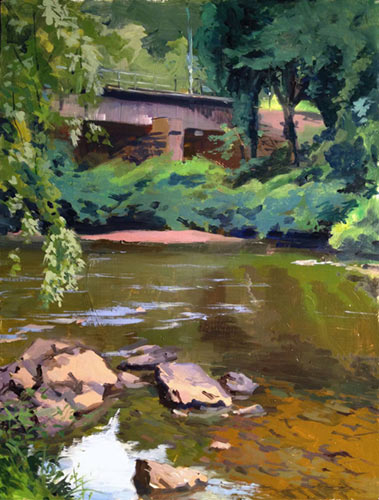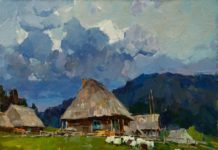Does Mike Manley collect art by his friends, or does he become friends with artists whose work he admires?
It’s impossible to say, although the ties that bind may be more like the kind that are forged in foxholes. Asked about the three paintings in his collection that he chose to discuss, the Philadelphia artist says, “All of them excite me. That’s a good painting, if it makes you want to paint.” And there’s no denying the other unifying trait of the three paintings he picked for this article: They are all done by friends he became close to while attending the Pennsylvania Academy of the Fine Arts.
The first piece is by Alexandra Thomas, and it’s a view of Manley’s house, done from his front yard. “It’s always fun to have a painting of your house by somebody else, because they see it in a different way,” says Manley. “I always like Lexi’s paintings because she takes a pretty bold approach to her plein air painting. I think she used some sort of spatula on this one.”

“Freedom Park,” by David Golas, oil, 16 x 16 in. Collection of Mike Manley
When asked about the perspective lines in the piece, Manley replies, “It’s not perfect linear perspective, but it is Lexi perspective, if that makes any sense. If you look at an Edwin Dickinson painting, there is a distorted bending of perspective that says right away that it is a Dickinson painting. If you know perspective, you can twist it. There’s a difference between a lack of ability and a conscious mistake. Even when she was a student in the Academy, her work stood out. You can develop a great technique, but not have much personality. That is one of the things I liked about her painting — it does not have a generic look to it.”
Next up is a portrait of a tree, by David Golas. “He was moving and giving away paintings to his friends,” says Manley. “I chose this one. You really feel the atmosphere, and you really feel the tree. It is a portrait, and the tree has a real personality to it. You don’t always get that sense from a landscape. And in general, you feel that day, with that level of humidity in the air, with that time of day, that day of the year. As a plein air piece, you get the bugs biting, the time restraint you deal with — it’s all in there. That’s what you really get from plein air painting that you need to take back into the studio.”

“Sunny Fields,” by Alina Osipov, oil, 9 x 12 in. Collection of Mike Manley
Manley says some pieces are a revelation because they show an artist making choices he wouldn’t make. His painting by Alina Osipov is one example. “She makes decisions I wouldn’t as a painter,” says Manley. “She pushes and pulls the space, and has interesting mark-making. I wouldn’t do that. But her eye says things like, ‘You need turquoise there.’ I got this painting because she hated it after she did it. So I asked for it. She often feels that way when she finishes one. You know how it is — everyone else says it is wonderful and you think they are just saying that to be nice. But again, this doesn’t feel generic. This is what attracts me to a good painting, the artists’ love of the world, their senses being translated onto canvas.”

“Darby Creek,” by Mike Manley, oil, 11 x 14 in.
Manley and the three artists featured here are part of a group of friends who call themselves the Dirty Palette Club. “We all went to the Pennsylvania Academy of the Fine Arts and we all had the same teachers, but you can see in the examples that there are three strong competent painters with distinct visions. I can learn from David, Lexi, Alina, and the others, and I do. I can learn something from what they do in every one of their paintings. Every painting is a series of decisions and problems that are solved. That is one of the best consequences of going to a school like PAFA — having a really tight group of friends when you are there. It’s really important for an artist to have a strong group of friends who are painters. Painting is hard, but having artist friends spurs you on, encourages you.”




